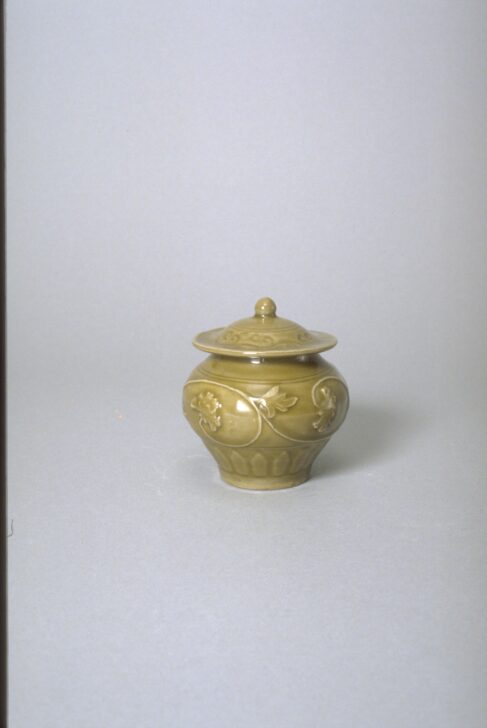Covered Jar
Chinese

Description
Longquan is the most representative, widespread, and esteemed ware of the Southern Song dynasty (1127–1279). Production started during the Five Dynasties period (907–960) at the kilns near the market town of Longquan, where in later dynasties much of the ware was collected for shipping. Technological advances such as the development of a multi-chambered, rising kiln and the use of stacked saggars (protective clay boxes) allowed for increased production in the Southern Song. In Yuan (1279–1368) and Ming (1368–1644) times, the kilns supplied wares to a domestic market as well as to overseas markets in Korea, Japan, and Southeast Asia.
Subject Matter:
Peonies are associated with wealth, imperial splendor, and the erotic appeal of a beautiful woman. In this small but exquisite example of Longquan ware, the circular contours of a peony scroll have been slightly compressed to complement the squat belly of the jar. The Longquan kiln in Zhejiang Province emerged as the primary center of celadon ceramics in second quarter of the thirteenth century, when the Song court established its southern capital at nearby Hangzhou. It reached its peak of production during the first quarter of the fourteenth century, when this jar was made, and were exported to markets in East and Southeast Asia, as well as the Middle East.
Physical Description:
This is a squat stoneware jar with a wide globular shoulder on a narrow foot ring. Lotus petal lappets surround the base, and a peony scroll relief surrounds the body. The jar has a domed lid top with a wide flange and a ball knob; the area between is incised with scrolling meander. The object is covered in an olive green celadon glaze.
Usage Rights:
If you are interested in using an image for a publication, please visit https://umma.umich.edu/request-image/ for more information and to fill out the online Image Rights and Reproductions Request Form.